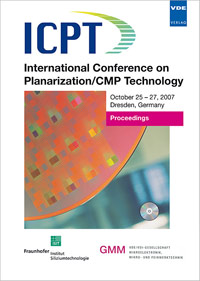Impact of ceria properties and CMP parameters on STI CMP performance
Konferenz: ICPT 2007 - International Conference on Planarization / CMP Technology
25.10.2007 - 27.10.2007 in Dresden, Germany
Tagungsband: ICPT 2007
Seiten: 6Sprache: EnglischTyp: PDF
Persönliche VDE-Mitglieder erhalten auf diesen Artikel 10% Rabatt
Autoren:
Messemaeker, Jo De; Put, Stijn; Nelis, Daniël; Bosch, Jeroen van den; Strauven, Yvan; Lippens, Paul (Umicore R&D, Kasteelstraat 7, B-2250 Olen, Belgium)
Sinapi, Fabrice; Ong, Patrick; Devriendt, Katia (AMPS Division, IMEC, Kapeldreef 75, B-3001 Leuven, Belgium)
Inhalt:
Ceria abrasives are increasingly being used in CMP for shallow trench isolation (STI). However the defectivity caused by these particles often still poses a problem, which will be even more significant at the smaller technology nodes. So there is a clear need for the development of ceria particles with considerably lower defectivity levels in combination with good removal rate. To enable this development, knowledge of the impact of ceria particle properties on STI CMP behaviour is essential. In this study the influence of specific surface area and particle shape on CMP performance was investigated. The particles are produced by a gas phase synthesis process, which was developed so as to provide a wide range of sizes and shapes. For these particles removal rate and post-CMP defectivity were evaluated on oxide sheet wafers. It was shown that finer particles do not necessarily produce fewer defects, while they do entail a significant removal rate loss. The impact of the particle shape was found to be limited. Surprisingly, quasi-spherical particles cause a higher defectivity than angular octahedral or truncated particles. Based on the results of the study an improved ceria abrasive was selected. The dependence of its CMP behaviour on solids content and polishing power input was charted, and the results on sheet wafers were complemented with tests on patterned wafers.


